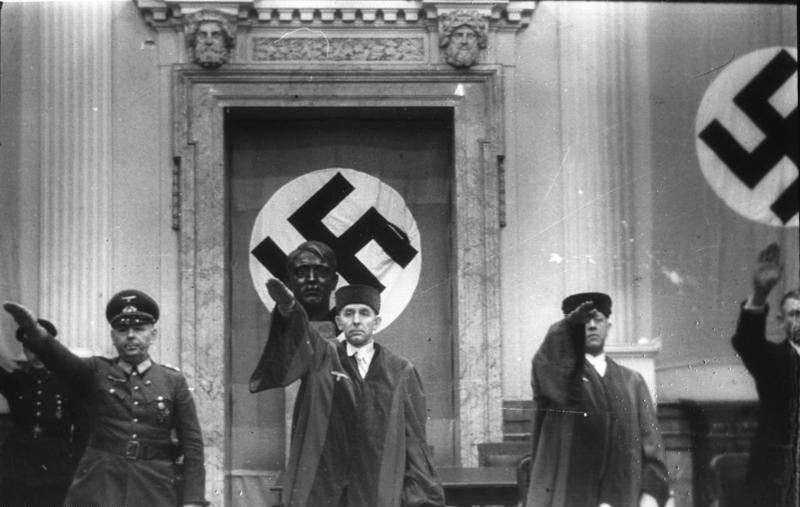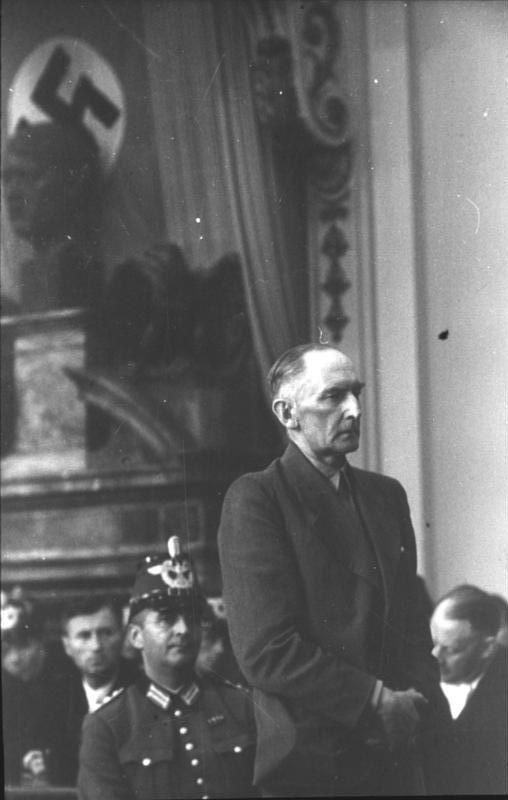|
Hermann Reinecke
Karl Rudolf Ernst Auguste Hermann Reinecke (14 February 1888 – 10 October 1973) generally known as Hermann Reinecke was a German general and war criminal during the Nazi era. As head of the General Office of the Armed Forces in the OKW (Supreme Command of the Wehrmacht) during World War II, he was a major contributor to the prisoner-of-war policy that resulted in the deaths of approx. 3.3 million Soviet prisoners. Reinecke was tried, convicted and sentenced to life imprisonment at the High Command Trial. Military career Reinecke joined the German Imperial Army as a cadet in March 1905. He served throughout World War I during which he was awarded the Iron Cross first class and he was promoted to captain in 1916. He then continued his military service in the Reichswehr with the Army Office of Administration, an infantry regiment and the Reich Defence Ministry in Berlin. He served in the Wehrmacht, providing political training on behalf of the Nazi leadership. In January 1939, ... [...More Info...] [...Related Items...] OR: [Wikipedia] [Google] [Baidu] |
Wittenberg
Wittenberg ( , ; Low Saxon language, Low Saxon: ''Wittenbarg''; meaning ''White Mountain''; officially Lutherstadt Wittenberg (''Luther City Wittenberg'')), is the fourth largest town in Saxony-Anhalt, Germany. Wittenberg is situated on the River Elbe, north of Leipzig and south-west of Berlin, and has a population of 46,008 (2018). Wittenberg is famous for its close connection with Martin Luther and the Protestant Reformation, for which it received the honourific ''Lutherstadt''. Several of Wittenberg's buildings are associated with the events, including a preserved part of the Augustinians, Augustinian monastery in which Luther lived, first as a monk and later as owner with his wife Katharina von Bora and family, considered to be the world's premier museum dedicated to Luther. Wittenberg was also the seat of the Elector of Saxony, a dignity held by the dukes of Duchy of Saxe-Wittenberg, Saxe-Wittenberg, making it one of the most powerful cities in the Holy Roman Empire. To ... [...More Info...] [...Related Items...] OR: [Wikipedia] [Google] [Baidu] |
Prisoner-of-war
A prisoner of war (POW) is a person who is held captive by a belligerent power during or immediately after an armed conflict. The earliest recorded usage of the phrase "prisoner of war" dates back to 1610. Belligerents hold prisoners of war in custody for a range of legitimate and illegitimate reasons, such as isolating them from the enemy combatants still in the field (releasing and repatriating them in an orderly manner after hostilities), demonstrating military victory, punishing them, prosecuting them for war crimes, exploiting them for their labour, recruiting or even conscripting them as their own combatants, collecting military and political intelligence from them, or indoctrinating them in new political or religious beliefs. Ancient times For most of human history, depending on the culture of the victors, enemy fighters on the losing side in a battle who had surrendered and been taken as prisoners of war could expect to be either slaughtered or enslaved. E ... [...More Info...] [...Related Items...] OR: [Wikipedia] [Google] [Baidu] |
Bundesarchiv Bild 151-39-23, Volksgerichtshof, Reinecke, Freisler, Lautz
, type = Archive , seal = , seal_size = , seal_caption = , seal_alt = , logo = Bundesarchiv-Logo.svg , logo_size = , logo_caption = , logo_alt = , image = Bundesarchiv Koblenz.jpg , image_caption = The Federal Archives in Koblenz , image_alt = , formed = , preceding1 = , preceding2 = , dissolved = , superseding1 = , superseding2 = , agency_type = , jurisdiction = , status = Active , headquarters = PotsdamerStraße156075Koblenz , coordinates = , motto = , employees = , budget = million () , chief1_name = Michael Hollmann , chief1_position = President of the Federal Archives , chief2_name = Dr. Andrea Hänger , chief2_position ... [...More Info...] [...Related Items...] OR: [Wikipedia] [Google] [Baidu] |
People's Court (Germany)
The People's Court (german: Volksgerichtshof, acronymed to ''VGH'') was a ' ("special court") of Nazi Germany, set up outside the operations of the constitutional frame of law. Its headquarters were originally located in the former Prussian House of Lords in Berlin, later moved to the former '' Königliches Wilhelms-Gymnasium'' at Bellevuestrasse 15 in Potsdamer Platz (the location now occupied by the Sony Center; a marker is located on the sidewalk nearby). The court was established in 1934 by order of Reich Chancellor Adolf Hitler, in response to his dissatisfaction at the outcome of the Reichstag fire trial in front of the Reich Court of Justice (''Reichsgericht'') in which all but one of the defendants were acquitted. The court had jurisdiction over a rather broad array of "political offenses", which included crimes like black marketeering, work slowdowns, defeatism, and treason against Nazi Germany. These crimes were viewed by the court as ''Wehrkraftzersetzung'' ("the dis ... [...More Info...] [...Related Items...] OR: [Wikipedia] [Google] [Baidu] |
Bendlerblock
The Bendlerblock is a building complex in the Tiergarten district of Berlin, Germany, located on Stauffenbergstraße (formerly named ''Bendlerstraße''). Erected in 1914 as headquarters of several Imperial German Navy (''Kaiserliche Marine'') offices, it served the Ministry of the Reichswehr after World War I. Significantly enlarged under Nazi rule, it was used by several departments of the '' Oberkommando der Wehrmacht'' (OKW) from 1938, especially the ''Oberkommando des Heeres'' and the '' Abwehr'' intelligence agency. The building is notable as the headquarters of a resistance band of Wehrmacht officers who staged the 20 July plot against Adolf Hitler in 1944. As the leaders of the conspiracy were summarily shot in the courtyard, the Bendlerblock also includes the Memorial to the German Resistance. Since 1993, the building complex has served as a secondary seat of the German Federal Ministry of Defence. Name The complex got its name from the street it was on. Today, it is ... [...More Info...] [...Related Items...] OR: [Wikipedia] [Google] [Baidu] |
Joseph Goebbels
Paul Joseph Goebbels (; 29 October 1897 – 1 May 1945) was a German Nazi politician who was the ''Gauleiter'' (district leader) of Berlin, chief propagandist for the Nazi Party, and then Reich Minister of Propaganda from 1933 to 1945. He was one of Adolf Hitler's closest and most devoted acolytes, known for his skills in public speaking and his deeply virulent antisemitism, which was evident in his publicly voiced views. He advocated progressively harsher discrimination, including the extermination of the Jews in the Holocaust. Goebbels, who aspired to be an author, obtained a Doctor of Philology degree from the University of Heidelberg in 1921. He joined the Nazi Party in 1924, and worked with Gregor Strasser in its northern branch. He was appointed ''Gauleiter'' of Berlin in 1926, where he began to take an interest in the use of propaganda to promote the party and its programme. After the Nazis came to power in 1933, Goebbels's Propaganda Ministry quickly gained a ... [...More Info...] [...Related Items...] OR: [Wikipedia] [Google] [Baidu] |
20 July Plot
On 20 July 1944, Claus von Stauffenberg and other conspirators attempted to assassinate Adolf Hitler, Führer of Nazi Germany, inside his Wolf's Lair field headquarters near Rastenburg, East Prussia, now Kętrzyn, in present-day Poland. The name "Operation Valkyrie"—originally referring to part of the conspiracy—has become associated with the entire event. The apparent aim of the assassination attempt was to wrest political control of Germany and its armed forces from the Nazi Party (including the SS) and to make peace with the Western Allies of World War II, Allies as soon as possible. The details of the conspirators' peace initiatives remain unknown, but they would have included unrealistic demands for the confirmation of Germany's extensive annexations of European territory. The plot was the culmination of efforts by several groups in the German resistance to Nazism, German resistance to overthrow the Nazi German government. The failure of the assassination attempt an ... [...More Info...] [...Related Items...] OR: [Wikipedia] [Google] [Baidu] |
Heinrich Himmler
Heinrich Luitpold Himmler (; 7 October 1900 – 23 May 1945) was of the (Protection Squadron; SS), and a leading member of the Nazi Party of Germany. Himmler was one of the most powerful men in Nazi Germany and a main architect of the Holocaust. As a member of a reserve battalion during World War I, Himmler did not see active service, and did not fight. He studied agriculture in university, and joined the Nazi Party in 1923 and the SS in 1925. In 1929, he was appointed by Adolf Hitler. Over the next 16 years, he developed the SS from a 290-man battalion into a million-strong paramilitary group, and set up and controlled the Nazi concentration camps. He was known for good organisational skills and for selecting highly competent subordinates, such as Reinhard Heydrich in 1931. From 1943 onwards, he was both Chief of German Police and Minister of the Interior, overseeing all internal and external police and security forces, including the Gestapo (Secret State Police). H ... [...More Info...] [...Related Items...] OR: [Wikipedia] [Google] [Baidu] |
Führerreserve
The (“Leaders Reserve” or "Reserve for Leaders") was set up in the German Armed Forces during World War II in 1939 as a pool of temporarily unoccupied high-ranking military officers awaiting new assignments. The various military branches and army groups each had their own pools that they could use as they saw fit. The officers were required to remain at their assigned stations and be available to their superiors but could not exercise any command function, which was in effect equivalent to a temporary retirement while retaining their previous active income. Especially in the second half of the war, more and more politically problematic, troublesome, or militarily incompetent officers were assigned to the . Etymology The name does not allude to Adolf Hitler Adolf Hitler (; 20 April 188930 April 1945) was an Austrian-born German politician who was dictator of Nazi Germany, Germany from 1933 until Death of Adolf Hitler, his death in 1945. Adolf Hitler's rise to power, ... [...More Info...] [...Related Items...] OR: [Wikipedia] [Google] [Baidu] |
Nationalsozialistischer Führungsoffizier
(NSFO; "National Socialist Leadership Officers") were officers of the German in World War II tasked with teaching Nazi ideology to soldiers. It was regarded as important that some officers should have the responsibility of both military command and political instruction in the spirit of Nazism. In this respect, NSFO were different from political commissars of the Red Army, who did not have military command. The (National Socialist leadership staff) of the OKW was created by Adolf Hitler's directive of the 22 December 1943 and was put under the overall control of General Hermann Reinecke. His officers had to bring soldiers closer to the Nazi worldview through lectures and discussion. The goal was to instill ideological conviction in order to reinforce combat morale and turn the tide of the war. NSFO were regular officers, but they had to be approved by a commission created by the head of the Nazi Party Chancellery Martin Bormann. This commission, presided by Wilhelm Rude ... [...More Info...] [...Related Items...] OR: [Wikipedia] [Google] [Baidu] |
Berlin
Berlin ( , ) is the capital and largest city of Germany by both area and population. Its 3.7 million inhabitants make it the European Union's most populous city, according to population within city limits. One of Germany's sixteen constituent states, Berlin is surrounded by the State of Brandenburg and contiguous with Potsdam, Brandenburg's capital. Berlin's urban area, which has a population of around 4.5 million, is the second most populous urban area in Germany after the Ruhr. The Berlin-Brandenburg capital region has around 6.2 million inhabitants and is Germany's third-largest metropolitan region after the Rhine-Ruhr and Rhine-Main regions. Berlin straddles the banks of the Spree, which flows into the Havel (a tributary of the Elbe) in the western borough of Spandau. Among the city's main topographical features are the many lakes in the western and southeastern boroughs formed by the Spree, Havel and Dahme, the largest of which is Lake Müggelsee. Due to its l ... [...More Info...] [...Related Items...] OR: [Wikipedia] [Google] [Baidu] |









